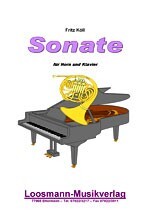 Loosmann MusikverlagStil:
Loosmann MusikverlagStil:  MusicalAusgabe: NotenArt-Nr.: K22796 / S0352 Level:
MusicalAusgabe: NotenArt-Nr.: K22796 / S0352 Level:
Vorwort
Die Sonate für Horn und Klavier ist als Duo-Sonate mit beiden Instrumenten als musikalisch gleichberechtigten Partnern konzipiert. Der Hornpart vermeidet ausgesetzte Höhen oder Tiefen, fordert jedoch eine klanglich kultivierte und flexible Mittellage.
Der 1. Satz Allegretto poetico ist als Sonatensatz strukturiert und lebt von reizvollen
Stimmungskontrasten. Ein markanter Hornruf zu Beginn bildet die motivische Grundlage des
Hauptsatzes, während der Seitensatz durch ein tänzerisches Motiv in punktiertem Rhythmus
gestaltet wird.
Der 2. Satz Scherzo bavarese ist von der bajuwarischen Lust am Wechsel von 2er und 3er
Takt geprägt. Der Zwiefache Volkstanz wird in den Händen von Fritz Köll zur zeitgemäßen Kunst
und weckt ausgelassene Spielfreude und Spiellaune bei Hornist und Pianist in gleichem Maße.
Grundgedanke des 3. Satzes Notturno ist die Atmosphäre des Gedichts Traumsommernacht von
O.J. Bierbaum. Die laue Traumsommernacht im Mondschein, der sich in einem See spiegelt wird in der
kantablen, immer leicht beschwingten Melodik spür- und erlebbar.
Einen anderen Text von Bierbaum vertonte Fritz Köll in der Chorkomposition Sommerglücksmusik, die
als musikalische Grundlage für den Schlusssatz Finaletto dient. Ein kurzes fließend bewegtes Rondo
im 6/8-Takt weckt bei beiden Instrumentalisten ausgelassene Spielfreude und bringt damit anschaulich
das Sommerglück zum Ausdruck.
Albert Schwarzmann
Preface
The Sonate for the horn and piano was conceived as a duo sonata with both instruments playing as
musically equal partners. The part for the horn avoids extreme highs and lows: however, it requires a
tonally cultivated and flexible central range.
The first movement Allegretto poetico is structured as a sonata movement and thrives on charming
contrasts in the mood. A striking horn call at the beginning forms the thematic foundation of the
main/central movement, while the secondary movement is formed by a dance motif in punctured rhythm.
The second movement Scherzo bavarese is characterized by the Baiuwariian fancy for the switch from
two to three beats. The two-time folk dance becomes contemporary art in the hands of Fritz Koell and
arouses exuberant pleasure and temper for playing in both the hornist and pianist.
The main theme of the 3rd movement is the spirit of the poem Traumsommernacht by O.J. Bierbaum.
The mild dream summer night in the moonlight, the moons reflection in the lake can be felt and
experienced in the cantabile, always slightly bouncy melody.
Fritz Koell set another one of Bierbaums texts to music in the choir composition Sommerglücksmusik,
which serves as the musical foundation for the final movement Finaletto. A short, flowingly lively rondo
in 6/8 time stirs up exuberant playing pleasure in both instrumentalists, thereby vividly expressing the
feeling of summer happiness.
Albert Schwarzmann
Translation: Alexander Biewald





